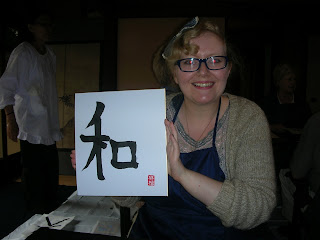Washi Paper
Wa means Japanese and shi means paper. It is a traditional paper made completely by hand (as you can see in the picture below). It is made by stripping, drying and pulping together the fibre from the gampi tree, the mitsumata shrub, the paper mulberry and the tororo plant. The pulp is put into a big vat and the paper maker dips screens into the vat to produce the sheets of paper. The sheets are then pressed and dried.

Here are the sheets of paper my mum and I made:

Calligraphy
There are five styles of Japanese calligraphy. The character I produced is in the kaisho / regular script style (a formal style). Japanese calligraphy generally involves black ink, a brush, washi paper, a weight to hold the paper down with and a name seal. There are three main types of brush strokes (all of which you can see in my character). The first stroke is one where you press down at the beginning and the end of the stroke, the second is one where you press down at the beginning and trail off the pressure as you reach the end and the third is where you press down at the beginning and flick at the end (but not too much). Unlike writing you must have a rigid arm and hand. You must hold the brush 90 degrees to the paper. To generate the variety in strokes you have to be very confident - pressing lightly will produce thin lines which are not very aesthetic.
This character is wa which we now know means Japanese. It also means harmony. (I don't think the photo could be any more unflattering if it tried).
Tea Ceremony
Traditional tea ceremonies last up to six hours and not only include tea but a whole meal. They are very formal affairs with many rules. The green tea used is the bitter matcha tea. The matcha is whisked into the hot water rather than infused. To make the tea more palatable it is served with very sugary sweets. Sweets, bowls and kimonos are all carefully chosen to reflect the season the ceremony is taking place in eg in spring petal patterns in pink are preferred. People are allowed to talk during the ceremony at certain points however subjects must be peaceful ones such as the weather rather than ones that could cause arguments such as politics. If you are given a bowl to drink from with a pattern on which has an obvious front and back you much turn the bowl so that the pattern faces away from you to honour the pattern, your host's decision to pick it and the person who made it.
Here is an example of a spring tea ceremony sweet on a traditional pottery plate:
I also took part in an origami lesson (I made a box and samurai hat) and an ikebana (flower arranging) demonstration.
Origami is paper folding. Proper origami does not use tears or scissors and uses only one piece of paper. Here are some simple origami patterns for you to try.
Ikebana is incredibly complicated and takes years to master. The two main differences between Japanese and Western flower arranging are: 1) whereas Western arrangements are meant to be viewed from all angles ikebana has a back and front, 2) ikebana is as much about the negative space between the plants as the placement of the plants themselves - less plants are used and therefore much more importance is placed on the individual plants that are used in ikebana compared to Western flower arranging.
Here is a video that explains the basics of ikebana:


Ahh, this is so cool, you got to learn about so much stuff! Your washi paper is lovely :) xx
ReplyDeletewww.jessthetics.wordpress.com
Such a great post. The paper you guys made is so pretty! Love the calligraphy too and the tea ceremony.
ReplyDelete